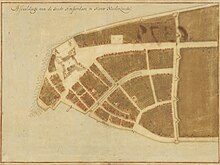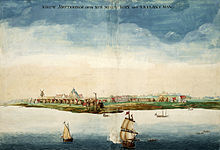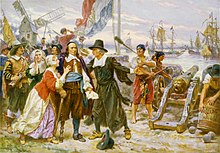
A | B | C | D | E | F | G | H | CH | I | J | K | L | M | N | O | P | Q | R | S | T | U | V | W | X | Y | Z | 0 | 1 | 2 | 3 | 4 | 5 | 6 | 7 | 8 | 9
New York | |
|---|---|
Midtown Manhattan with the Empire State Building (center) and Lower Manhattan with One WTC in the background | |
| Nicknames: | |
 Interactive map outlining New York City | |
| Coordinates: 40°42′46″N 74°00′21″W / 40.7127°N 74.0059°W[2] | |
| Country | |
| State | |
| Constituent counties (boroughs) | Bronx (The Bronx) Kings (Brooklyn) New York (Manhattan) Queens (Queens) Richmond (Staten Island) |
| Settled | 1624 |
| Consolidated | 1898 |
| Named for | James, Duke of York |
| Government | |
| • Type | Strong mayor–council |
| • Body | New York City Council |
| • Mayor | Eric Adams (D) |
| Area | |
| • Total | 472.43 sq mi (1,223.59 km2) |
| • Land | 300.46 sq mi (778.18 km2) |
| • Water | 171.97 sq mi (445.41 km2) |
| Highest elevation | 401 ft (122 m) |
| Lowest elevation | 0 ft (0 m) |
| Population | |
| • Total | 8,804,190 |
| • Estimate (July 2022)[4] | 8,335,897 |
| • Rank | 1st in the United States 1st in New York State |
| • Density | 29,302.66/sq mi (11,313.81/km2) |
| • Urban | 19,426,449 |
| • Urban density | 5,980.8/sq mi (2,309.2/km2) |
| • Metro | 20,140,470 |
| Demonym | New Yorker |
| GDP | |
| • Total | $1.21 trillion (2022) |
| • Metro | $2.16 trillion (2022) (1st) |
| Time zone | UTC–05:00 (EST) |
| • Summer (DST) | UTC–04:00 (EDT) |
| ZIP Codes | 100xx–104xx, 11004–05, 111xx–114xx, 116xx |
| Area codes | 212/646/332, 718/347/929, 917 |
| FIPS code | 36-51000 |
| GNIS feature ID | 975772 |
| Website | nyc |
New York, often called New York City[b] or simply NYC, is the most populous city in the United States, located at the southern tip of New York State on one of the world's largest natural harbors. The city comprises five boroughs, each of which is coextensive with a respective county. New York is a global center of finance[10] and commerce, culture and tech,[11] entertainment and media, academics and scientific output,[12] and the arts and fashion. Home to the headquarters of the United Nations, New York is an important center for international diplomacy,[13][14] and is sometimes described as the world's most important city[15] and the capital of the world.[16][17]
With an estimated population in 2022 of 8,335,897 distributed over 300.46 square miles (778.2 km2),[4] the city is the most densely populated major city in the United States. New York has more than double the population of Los Angeles, the nation's second-most populous city.[18] New York is the geographical and demographic center of both the Northeast megalopolis and the New York metropolitan area, the largest metropolitan area in the U.S. by both population and urban area. With more than 20.1 million people in its metropolitan statistical area[19] and 23.5 million in its combined statistical area as of 2020, New York City is one of the world's most populous megacities.[20] The city and its metropolitan area are the premier gateway for legal immigration to the United States. As many as 800 languages are spoken in New York,[21] making it the most linguistically diverse city in the world. In 2021, the city was home to nearly 3.1 million residents born outside the U.S.,[18] the largest foreign-born population of any city in the world.[22]
New York City traces its origins to Fort Amsterdam and a trading post founded on the southern tip of Manhattan Island by Dutch colonists in approximately 1624. The settlement was named New Amsterdam (Dutch: Nieuw Amsterdam) in 1626 and was chartered as a city in 1653. The city came under English control in 1664 and was temporarily renamed New York after King Charles II granted the lands to his brother, the Duke of York.[23] before being permanently renamed New York in November 1674. New York City was the capital of the United States from 1785 until 1790.[24] The modern city was formed by the 1898 consolidation of its five boroughs: Manhattan, Brooklyn, Queens, The Bronx, and Staten Island, and has been the largest U.S. city ever since.
Anchored by Wall Street in the Financial District of Lower Manhattan, New York City has been called both the world's premier financial and fintech center[25][26] and the most economically powerful city in the world.[27] As of 2022[update], the New York metropolitan area is the largest metropolitan economy in the world with a gross metropolitan product of over US$2.16 trillion.[7][8] If the New York metropolitan area were its own country, it would have the tenth-largest economy in the world. The city is home to the world's two largest stock exchanges by market capitalization of their listed companies: the New York Stock Exchange and Nasdaq. New York City is an established safe haven for global investors.[28] As of 2023[update], New York City is the most expensive city in the world for expatriates to live.[29] New York City is home to the highest number of billionaires, individuals of ultra-high net worth (greater than US$30 million),[30] and millionaires of any city in the world.[31]
Etymology
In 1664, New York was named in honor of the Duke of York (later King James II of England).[32] James's elder brother, King Charles II, appointed the Duke as proprietor of the former territory of New Netherland, including the city of New Amsterdam, when the Kingdom of England seized it from Dutch control.[33]
History
Early history
In the pre-Columbian era, the area of present-day New York City was inhabited by Algonquians, including the Lenape. Their homeland, known as Lenapehoking, included the present-day areas of Staten Island, Manhattan, the Bronx, the western portion of Long Island (including Brooklyn and Queens), and the Lower Hudson Valley.[34]
The first documented visit into New York Harbor by a European was in 1524 by Giovanni da Verrazzano, an explorer from Florence in the service of the French crown.[35] He claimed the area for France and named it Nouvelle Angoulême (New Angoulême).[36] A Spanish expedition, led by the Portuguese captain Estêvão Gomes sailing for Emperor Charles V, arrived in New York Harbor in January 1525 and charted the mouth of the Hudson River, which he named Río de San Antonio ('Saint Anthony's River').[37]
In 1609, the English explorer Henry Hudson rediscovered New York Harbor while searching for the Northwest Passage to the Orient for the Dutch East India Company.[38] He proceeded to sail up what the Dutch called North River (now the Hudson River), named first by Hudson as the Mauritius after Maurice, Prince of Orange. Hudson's first mate described the harbor as "a very good Harbour for all windes" and the river as "a mile broad" and "full of fish."[39]
Hudson claimed the region for the Dutch East India Company. In 1614, the area between Cape Cod and Delaware Bay was claimed by the Netherlands and called Nieuw-Nederland ('New Netherland'). The first non–Native American inhabitant of what became New York City was Juan Rodriguez, a merchant from Santo Domingo who arrived in Manhattan during the winter of 1613–14, trapping for pelts and trading with the local population as a representative of the Dutch colonists.[40][41]
Dutch rule
A permanent European presence near New York Harbor was established in 1624, making New York the 12th-oldest continuously occupied European-established settlement in the continental United States, with the founding of a Dutch fur trading settlement on Governors Island. In 1625, construction was started on a citadel and Fort Amsterdam, later called Nieuw Amsterdam (New Amsterdam), on present-day Manhattan Island.[42][43]
The colony of New Amsterdam was centered on what became Lower Manhattan. Its area extended from the southern tip of Manhattan to modern-day Wall Street, where a 12-foot (3.7 m) wooden stockade was built in 1653 to protect against Native American and English raids.[44] In 1626, the Dutch colonial Director-General Peter Minuit, acting as charged by the Dutch West India Company, purchased the island of Manhattan from the Canarsie, a small Lenape band,[45] for "the value of 60 guilders"[46] (about $900 in 2018).[47] A frequently told but disproved legend claims that Manhattan was purchased for $24 worth of glass beads.[48][49]
Following the purchase, New Amsterdam grew slowly.[23] To attract settlers, the Dutch instituted the patroon system in 1628, whereby wealthy Dutchmen (patroons, or patrons) who brought 50 colonists to New Netherland would be awarded swaths of land, along with local political autonomy and rights to participate in the lucrative fur trade. This program had little success.[50]
Since 1621, the Dutch West India Company had operated as a monopoly in New Netherland, on authority granted by the Dutch States General. In 1639–1640, in an effort to bolster economic growth, the Dutch West India Company relinquished its monopoly over the fur trade, leading to growth in the production and trade of food, timber, tobacco, and slaves (particularly with the Dutch West Indies).[23][51]
In 1647, Peter Stuyvesant began his tenure as the last Director-General of New Netherland. During his tenure, the population of New Netherland grew from 2,000 to 8,000.[52][53] Stuyvesant has been credited with improving law and order in the colony; however, he earned a reputation as a despotic leader. He instituted regulations on liquor sales, attempted to assert control over the Dutch Reformed Church, and blocked other religious groups (including Quakers, Jews, and Lutherans) from establishing houses of worship.[54] The Dutch West India Company attempted to ease tensions between Stuyvesant and residents of New Amsterdam.[55]
English rule
In 1664, unable to summon any significant resistance, Stuyvesant surrendered New Amsterdam to English troops, led by Colonel Richard Nicolls, without bloodshed.[54][55] The terms of the surrender permitted Dutch residents to remain in the colony and allowed for religious freedom.[56]
In 1667, during negotiations leading to the Treaty of Breda after the Second Anglo-Dutch War, the victorious Dutch decided to keep the nascent plantation colony of what is now Suriname on the northern South American coast, which they had gained from the English;[57] and in return, the English kept New Amsterdam. The fledgling settlement was promptly renamed "New York" after the Duke of York (the future King James II and VII).[58] After the founding, the duke gave part of the colony to proprietors George Carteret and John Berkeley. Fort Orange, 150 miles (240 km) north on the Hudson River, was renamed Albany after James's Scottish title.[59]
On August 24, 1673, during the Third Anglo-Dutch War, Anthony Colve of the Dutch navy seized New York from the English at the behest of Cornelis Evertsen the Youngest and rechristened it "New Orange" after William III, the Prince of Orange.[60] The Dutch soon returned the island to England under the Treaty of Westminster of November 1674.[61][62]
Several intertribal wars among the Native Americans and some epidemics brought on by contact with the Europeans caused sizeable population losses for the Lenape between the years 1660 and 1670.[63] By 1700, the Lenape population had diminished to 200.[64] New York experienced several yellow fever epidemics in the 18th century, losing ten percent of its population in 1702 alone.[65][66]
In the early 18th century, New York grew in importance as a trading port while as a part of the colony of New York.[67] It became a center of slavery, with 42% of households enslaving Africans by 1730.[68] Most cases were that of domestic slavery; others were hired out to work at labor. Slavery became integrally tied to New York's economy through the labor of slaves throughout the port, and the banking and shipping industries trading with the American South. During construction in Foley Square in the 1990s, the African Burying Ground was discovered; the cemetery included 10,000 to 20,000 of graves of colonial-era Africans, some enslaved and some free.[69]
The 1735 trial and acquittal in Manhattan of John Peter Zenger, who had been accused of seditious libel after criticizing colonial governor William Cosby, helped to establish freedom of the press in North America.[70] In 1754, Columbia University was founded under charter by King George II as King's College in Lower Manhattan.[71]
American Revolution

The Stamp Act Congress met in New York in October 1765, as the Sons of Liberty organization emerged in the city and skirmished over the next ten years with British troops stationed there.[72] The Battle of Long Island, the largest battle of the American Revolutionary War, was fought in August 1776 within the modern-day borough of Brooklyn.[73] A British rout of the Continental Army at the Battle of Fort Washington in November 1776 eliminated the last American stronghold in Manhattan, causing George Washington and his forces to retreat across the Hudson River to New Jersey, pursued by British forces.[74][75]
After the battle, in which the Americans were defeated, the British made the city their military and political base of operations in North America.[76] The city was a haven for Loyalist refugees and escaped slaves who joined the British lines for freedom newly promised by the Crown, with as many as 10,000 escaped slaves crowded into the city during the British occupation, which had become the largest such community on the continent.[77][78] When the British forces evacuated New York at the close of the war in 1783, they transported thousands of freedmen for resettlement in Nova Scotia, England, and the Caribbean.[79]
The attempt at a peaceful solution to the war took place at the Conference House on Staten Island between American delegates, including Benjamin Franklin, and British general Lord Howe on September 11, 1776.[80] Shortly after the British occupation began, the Great Fire of New York occurred, a large conflagration on the West Side of Lower Manhattan, which destroyed nearly 500 buildings, about a quarter of the structures in the city, including Trinity Church.[81][82]
Post-revolutionary period and early 19th century
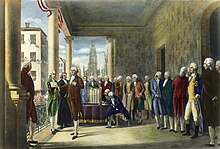
In January 1785, the assembly of the Congress of the Confederation made New York City the national capital, shortly after the war.[83] New York was the last capital of the U.S. under the Articles of Confederation and the first capital under the Constitution of the United States.[84] As the U.S. capital, New York City hosted several events of national scope in 1789; the first President of the United States, George Washington, was inaugurated; the first United States Congress and the Supreme Court of the United States each assembled for the first time; and the United States Bill of Rights was drafted, all at Federal Hall on present-day Wall Street.[84]
In 1790, for the first time, New York City surpassed Philadelphia as the nation's largest city. At the end of 1790, the national capital was moved to Philadelphia.[85][86]
During the 19th century, New York City's population grew from 60,000 to 3.43 million.[87] Under New York State's gradual emancipation act of 1799, children of slave mothers were to be eventually liberated but to be held in indentured servitude until their mid-to-late twenties.[88][89] Together with slaves freed by their masters after the Revolutionary War and escaped slaves, a significant free-Black population gradually developed in Manhattan. Under such influential United States founders as Alexander Hamilton and John Jay, the New York Manumission Society worked for abolition and established the African Free School to educate Black children.[90] It was not until 1827 that slavery was completely abolished in the state.[91] Free Blacks struggled afterward with discrimination and interracial abolitionist activism continued. New York City's population jumped from 123,706 in 1820 (10,886 of whom were Black and of which 518 were enslaved) to 312,710 by 1840 (16,358 of whom were Black).[92]
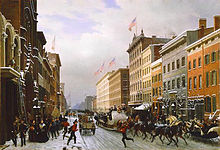
Also in the 19th century, the city was transformed by both commercial and residential development relating to its status as a national and international trading center, as well as by European immigration, respectively.[94] The city adopted the Commissioners' Plan of 1811, which expanded the city street grid to encompass almost all of Manhattan. The 1825 completion of the Erie Canal through central New York connected the Atlantic port to the agricultural markets and commodities of the North American interior via the Hudson River and the Great Lakes.[95] Local politics became dominated by Tammany Hall, a political machine supported by Irish and German immigrants.[96]
Several prominent American literary figures lived in New York during the 1830s and 1840s, including William Cullen Bryant, Washington Irving, Herman Melville, Rufus Wilmot Griswold, John Keese, Nathaniel Parker Willis, and Edgar Allan Poe. Public-minded members of the contemporaneous business elite lobbied for the establishment of Central Park, which in 1857 became the first landscaped park in an American city.[97]
The Great Irish Famine brought a large influx of Irish immigrants, of whom more than 200,000 were living in New York by 1860, representing upward of one-quarter of the city's population.[98] There was also extensive immigration from the German provinces, where revolutions had disrupted societies, and Germans comprised another 25% of New York's population by 1860.[99][100]
American Civil War

Democratic Party candidates were consistently elected to local office, increasing the city's ties to the South and its dominant party. In 1861, Mayor Fernando Wood called on the aldermen to declare independence from Albany and the United States after the South seceded, but his proposal was not acted on.[90] Anger at new military conscription laws during the American Civil War (1861–1865), which spared wealthier men who could afford to hire a substitute, led to the Draft Riots of 1863, whose most visible participants were ethnic Irish working class.[90]
The draft riots deteriorated into attacks on New York's elite, followed by attacks on Black New Yorkers and their property after fierce competition for a decade between Irish immigrants and Black people for work. Rioters burned the Colored Orphan Asylum to the ground, with more than 200 children escaping harm due to efforts of the New York Police Department, which was mainly made up of Irish immigrants.[99]
At least 120 people were killed.[101] Eleven Black men were lynched over five days, and the riots forced hundreds of Blacks to flee. The Black population in Manhattan fell below 10,000 by 1865. The White working class had established dominance.[99][101] Violence by longshoremen against Black men was especially fierce in the docks area.[99] It was one of the worst incidents of civil unrest in American history.[102]
Late 19th and early 20th century

In 1886, the Statue of Liberty, a gift from France, was dedicated in New York Harbor. The statue welcomed 14 million immigrants as they came to the U.S. via Ellis Island by ship in the late 19th and early 20th centuries, and is a symbol of the United States and American ideals of liberty and peace.[103][104]
In 1898, the City of New York was formed with the consolidation of Brooklyn (until then a separate city), the County of New York (which then included parts of the Bronx), the County of Richmond, and the western portion of the County of Queens.[105] The opening of the New York City Subway in 1904, first built as separate private systems, helped bind the new city together.[106] Throughout the first half of the 20th century, the city became a world center for industry, commerce, and communication.[107]
In 1904, the steamship General Slocum caught fire in the East River, killing 1,021 people on board.[108] In 1911, the Triangle Shirtwaist Factory fire, the city's worst industrial disaster, killed 146 garment workers and spurred the growth of the International Ladies' Garment Workers' Union and major improvements in factory safety standards.[109]
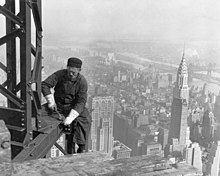
New York's non-White population was 36,620 in 1890.[110] New York City was a prime destination in the early 20th century for African Americans during the Great Migration from the American South, and by 1916, New York City had become home to the largest urban African diaspora in North America.[111] The Harlem Renaissance of literary and cultural life flourished during the era of Prohibition.[112] The larger economic boom generated construction of skyscrapers competing in height.[113]
New York City became the most populous urbanized area in the world in the early 1920s, overtaking London. The metropolitan area surpassed the 10 million mark in the early 1930s, becoming the first megacity in human history.[114] The Great Depression saw the election of reformer Fiorello La Guardia as mayor and the fall of Tammany Hall after eighty years of political dominance.[115]
Returning World War II veterans created a post-war economic boom and the development of large housing tracts in eastern Queens and Nassau County. New York emerged from the war unscathed as the leading city of the world, with Wall Street leading America's place as the world's dominant economic power. The United Nations headquarters was completed in 1952, solidifying New York's global geopolitical influence, and the rise of abstract expressionism in the city precipitated New York's displacement of Paris as the center of the art world.[116]
Late 20th and early 21st centuries

In 1969, the Stonewall riots were a series of spontaneous, violent protests by members of the gay community against a police raid that took place in the early morning of June 28, 1969, at the Stonewall Inn in the Greenwich Village neighborhood of Lower Manhattan.[120] They are widely considered to be the single most important event leading to the gay liberation movement[117][121][122][123] and the modern fight for LGBT rights.[124][125] Wayne R. Dynes, author of the Encyclopedia of Homosexuality, wrote that drag queens were the only "transgender folks around" during the June 1969 Stonewall riots. The transgender community in New York City played a significant role in fighting for LGBT equality during the period of the Stonewall riots and thereafter.[126]
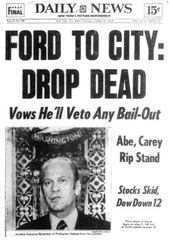
In the 1970s, job losses due to industrial restructuring caused New York City to suffer from economic problems and rising crime rates.[127] Growing fiscal deficits in 1975 led the city to appeal to the federal government for financial aid; President Gerald Ford gave a speech denying the request, which was paraphrased on the front page of the next day's issue of the New York Daily News as "FORD TO CITY: DROP DEAD."[128] The Municipal Assistance Corporation was formed and granted oversight authority over the city's finances.[129] While a resurgence in the financial industry greatly improved the city's economic health in the 1980s, New York's crime rate continued to increase through that decade and into the beginning of the 1990s.[130]
By the mid-1990s, crime rates started to drop dramatically due to revised police strategies, improving economic opportunities, gentrification, and new residents, both American transplants and new immigrants from Asia and Latin America.[citation needed] New York City's population exceeded 8 million for the first time in the 2000 United States census, breaking the previous peak census population set in the 1970 census;[131] further records were set in 2010, and 2020 U.S. censuses.[132] Important new sectors, such as Silicon Alley, emerged in the city's economy.[133]
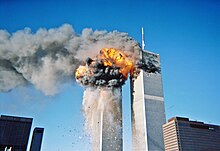
The advent of Y2K was celebrated with fanfare in Times Square.[134] New York City suffered the bulk of the economic damage and largest loss of human life in the aftermath of the September 11, 2001 attacks.[135] Two of the four airliners hijacked that day were flown into the twin towers of the World Trade Center, resulting in the collapse of both buildings and the deaths of 2,753 people, including 343 first responders from the New York City Fire Department and 71 law enforcement officers.[136] The North Tower became, and remains, the tallest building to ever be destroyed.[citation needed]
The area was rebuilt with a new World Trade Center, the National September 11 Memorial and Museum, and other new buildings and infrastructure,[137] including the World Trade Center Transportation Hub, the city's third-largest hub.[138] The new One World Trade Center is the tallest skyscraper in the Western Hemisphere[139] and the seventh-tallest building in the world by pinnacle height, with its spire reaching a symbolic 1,776 feet (541.3 m), a reference to the year of U.S. independence.[140][141][142]
The Occupy Wall Street protests in Zuccotti Park in the Financial District of Lower Manhattan began on September 17, 2011, receiving global attention and popularizing the Occupy movement against social and economic inequality worldwide.[143]
New York City was heavily affected by Hurricane Sandy in late October 2012. Sandy's impacts included flooding that led to the days-long shutdown of the subway system[144] and flooding of all East River subway tunnels and of all road tunnels entering Manhattan except the Lincoln Tunnel.[145] The New York Stock Exchange closed for two consecutive days due to weather for the first time since the Great Blizzard of 1888.[146] At least 43 people died in New York City as a result of Sandy, and the economic losses in New York City were estimated to be roughly $19 billion.[147] The disaster spawned long-term efforts towards infrastructural projects to counter climate change and rising seas, with $15 billion in federal funding received through 2022 towards those resiliency efforts.[148][149]
In March 2020, the first case of COVID-19 in the city was confirmed in Manhattan.[150] With its population density and its extensive exposure to global travelers, the city rapidly replaced Wuhan, China as the global epicenter of the pandemic during the early phase, straining the city's healthcare infrastructure.[151][152] Through March 2023, New York City had recorded more than 80,000 deaths from COVID-19-related complications.[153]
Geography

New York City is situated in the northeastern United States, in southeastern New York State, approximately halfway between Washington, D.C. and Boston. Its location at the mouth of the Hudson River, which feeds into a naturally sheltered harbor and then into the Atlantic Ocean, has helped the city grow in significance as a trading port. Most of the city is built on the three islands of Long Island, Manhattan, and Staten Island.
During the Wisconsin glaciation, 75,000 to 11,000 years ago, the New York City area was situated at the edge of a large ice sheet.[154] The erosive forward movement of the ice (and its subsequent retreat) contributed to the separation of what is now Long Island and Staten Island. That action left bedrock at a relatively shallow depth, providing a solid foundation for most of Manhattan's skyscrapers.[155]
The Hudson River flows through the Hudson Valley into New York Bay. Between New York City and Troy, New York, the river is an estuary.[156] The Hudson River separates the city from the New Jersey. The East River—a tidal strait—flows from Long Island Sound and separates the Bronx and Manhattan from Long Island. The Harlem River, another tidal strait between the East and Hudson rivers, separates most of Manhattan from the Bronx. The Bronx River, which flows through the Bronx and Westchester County, is the only entirely freshwater river in the city.[157][importance?]
The city's land has been altered substantially by human intervention, with considerable land reclamation along the waterfronts since Dutch colonial times; reclamation is most prominent in Lower Manhattan, with developments such as Battery Park City in the 1970s and 1980s.[158] Some of the natural relief in topography has been evened out, especially in Manhattan.[159]
The city's total area is 468.484 square miles (1,213.37 km2). 302.643 sq mi (783.84 km2) of the city is land and 165.841 sq mi (429.53 km2) of it is water.[160][161] The highest point in the city is Todt Hill on Staten Island, which, at 409.8 feet (124.9 m) above sea level, is the highest point on the eastern seaboard south of Maine.[162] The summit of the ridge is mostly covered in woodlands as part of the Staten Island Greenbelt.[163]
Boroughs

New York City is sometimes referred to collectively as the Five Boroughs.[164] Each borough is coextensive with a respective county of New York State, making New York City one of the U.S. municipalities in multiple counties.
Manhattan (New York County) is the geographically smallest and most densely populated borough. It is home to Central Park and most of the city's skyscrapers, and is sometimes locally known as The City.[165] Manhattan's population density of 70,450.8 inhabitants per square mile (27,201.2/km2) in 2022 makes it the highest of any county in the United States and higher than the density of any individual American city.[166] Manhattan is the cultural, administrative, and financial center of New York City and contains the headquarters of many major multinational corporations, the United Nations headquarters, Wall Street, and a number of important universities. The borough is often described as the financial and cultural center of the world.[167][168]
Brooklyn (Kings County), on the western tip of Long Island, is the city's most populous borough. Brooklyn is known for its cultural, social, and ethnic diversity, an independent art scene, distinct neighborhoods, and a distinctive architectural heritage. Downtown Brooklyn is the largest central core neighborhood in the Outer Boroughs. The borough has a long beachfront shoreline including Coney Island, established in the 1870s as one of the earliest amusement grounds in the U.S.[169] Marine Park and Prospect Park are the two largest parks in Brooklyn.[170] Since 2010, Brooklyn has evolved into a thriving hub of entrepreneurship and high technology startup firms,[171][172] and of postmodern art and design.[172][173] Brooklyn is also home to Fort Hamilton, the U.S. military's only active duty installation within New York City,[174] aside from Coast Guard operations. The facility was established in 1825 on the site of a battery used during the American Revolution, and it is one of America's longest-serving military forts.[175]
Queens (Queens County), on Long Island north and east of Brooklyn, is geographically the largest borough, the most ethnically diverse county in the United States,[176] and the most ethnically diverse urban area in the world.[177][178] Queens is the site of the Citi Field, home of the New York Mets, and hosts the annual U.S. Open tennis tournament at the USTA Billie Jean King National Tennis Center in Flushing Meadows–Corona Park, with plans to build a soccer-specific stadium to be built for New York City FC.[179] Additionally, two of the three busiest airports serving the New York metropolitan area, John F. Kennedy International Airport and LaGuardia Airport, are in Queens.[180]
The Bronx (Bronx County) is both New York City's northernmost borough and the only one that is mostly on the U.S. mainland. It is the location of Yankee Stadium, the baseball park of the New York Yankees, and home to the largest cooperatively-owned housing complex in the United States, Co-op City.[181] It is home to the Bronx Zoo, the world's largest metropolitan zoo,[182] which spans 265 acres (1.07 km2) and houses more than 6,000 animals.[183] The Bronx is the birthplace of hip hop music and its associated culture.[184] Pelham Bay Park is the largest park in New York City, at 2,772 acres (1,122 ha).[185]
Staten Island (Richmond County) is the most suburban in character of the five boroughs. It is connected to Brooklyn by the Verrazzano-Narrows Bridge, and to Manhattan by way of the free Staten Island Ferry. In central Staten Island, the Staten Island Greenbelt spans approximately 2,500 acres (10 km2), including 28 miles (45 km) of walking trails and one of the last undisturbed forests in the city.[186] Designated in 1984 to protect the island's natural lands, the Greenbelt comprises seven city parks.
Climate
| New York | ||||||||||||||||||||||||||||||||||||||||||||||||||||||||||||
|---|---|---|---|---|---|---|---|---|---|---|---|---|---|---|---|---|---|---|---|---|---|---|---|---|---|---|---|---|---|---|---|---|---|---|---|---|---|---|---|---|---|---|---|---|---|---|---|---|---|---|---|---|---|---|---|---|---|---|---|---|
| Climate chart (explanation) | ||||||||||||||||||||||||||||||||||||||||||||||||||||||||||||
| ||||||||||||||||||||||||||||||||||||||||||||||||||||||||||||















